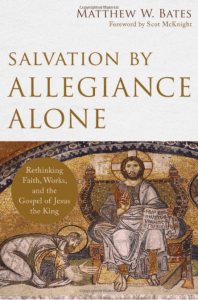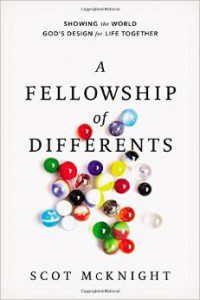 In a recent review in Books and Culture I examined what John Barclay calls a largely unexamined Christian theme — that’s right, grace is largely unexamined. Rather it is assumed we all know what it means. This was my book of the year on the Jesus Creed, so before I get going I want to say that I really, really like this book. While Barclay — in general — fits the apocalyptic school of Paul he does clearly transcend some of the boundaries and in some important ways carves his own path in the thicket.
In a recent review in Books and Culture I examined what John Barclay calls a largely unexamined Christian theme — that’s right, grace is largely unexamined. Rather it is assumed we all know what it means. This was my book of the year on the Jesus Creed, so before I get going I want to say that I really, really like this book. While Barclay — in general — fits the apocalyptic school of Paul he does clearly transcend some of the boundaries and in some important ways carves his own path in the thicket.
The singular contribution of this book is to articulate a multi-level and multi-dimensional theory of grace, one that can make each group think they fit and one that, if read carefully, might make each camp think they don’t fit. Barclay is not part of the uber Reformed, he’s not part of the Lutheran in all ways, and he’s not part of the new perspective (though he accepts the basics of Sanders’ original contributions about Judaism), and he does claim some strong apocalyptic themes but he’s not just J. Louis Martyn or Marin de Boer or Douglas Campbell or Bev Gaventa.
Perhaps what I thought was most innovative in Barclay was his observation that prior to Paul grace entailed reciprocation or response. Grace, in other words, wasn’t what many today call “pure gift” or “unconditional gift” or “pure grace.” Those who love the uber Lutheran approach will simply be offended by the ancient evidence.
I will quote a sizable chunk of the review (with some abbreviating), and then proceed to discussing how we can talk about grace in the church:
I shall proceed straight to the central contribution of Paul and the Gift. There are, Barclay contends, six different “perfections” of grace, by which he means six ways grace as gift works itself out toward extremes or its farthest point in meaning and implication. Those six perfections are superabundance, singularity, priority, incongruity, efficacy, and non-circularity. These perfections need his clarifications, for the whole book gains its vision from these terms:
We have noted the tendency to draw the theme of gift/grace to an end-of-the-line extreme, especially for polemical purposes and in relation to God; and we have observed the variety of forms that this “perfecting” tendency can take. Since gift-giving is a complex social relation, it is possible to “perfect” grace (to define its essence in some “pure” or “ultimate” form) in a number of ways. We have identified six possible perfections:
(i) superabundance: the supreme scale, lavishness, or permanence of the gift;
(ii) singularity: the attitude of the giver as marked solely and purely by benevolence;
(iii) priority: the timing of the gift before the recipient’s initiative;
(iv) incongruity: the distribution of the gift without regard to the worth of the recipient;
(v)efficacy: the impact of the gift on the nature or agency of the recipient;
(vi)non-circularity: the escape of the gift from an ongoing cycle of reciprocity.As he will later articulate, Barclay’s perfections of grace operate from different angles: the first is about the gift itself; the second and third about the giver (God), the fourth about the person to whom the gift is given, the fifth about its effect, while the last is about reciprocation. These perfections then illustrate the varied dimensions of a phenomenology of the gift.
Three implications of nuancing grace into these six perfections can be detailed. I begin with a general implication for understanding how to relate the six perfections of grace. Each of the perfections is grace; each can exist without the others; grace, in other words, is not always one or all the others but can be one of them or a mixture of various perfections. Thus, it is simply unfair to the ancient Greco-Roman and Jewish worlds to think it is only grace when it is superabundance and incongruity and non-circularity, and here Barclay has his eye on certain exaggerations—prominent today in church life in the US—in Lutheran and Reformed theology. …
A second implication immediately rises to the surface for those who have learned to think in terms of grace being reducible to superabundance,incongruity, and non-circularity. What about Paul’s theology of grace? Isn’t it as we have learned in the tradition? Barclay’s answer is yes and no. In his opening summary, Barclay lays out his understanding of grace in Galatians and Romans. Here is his thesis for Paul: “Paul s theology of grace characteristically perfects the incongruity of the Christ-gift, given without regard to worth.”
Barclay transcends Augustinian anthropology in the term “worth,” for he is thinking not only of soteriology but also of how honor and worth were established in the Greco-Roman and Jewish worlds, a worth that has now been transcended by equality in Christ. Thus, he continues (all italics that follow are mine):
This theology is articulated within and for Paul’s Gentile mission, and grounds the formation of innovative communities that crossed ethnic and other boundaries. This incongruous gift bypasses and thussubverts pre-constituted systems of worth. It disregards previousforms of symbolic capital and thus enables the creation of new communities whose norms are reset by the Christ-gift itself. Grace took its meaning in and from Paul’s experience and social practice: the nature of the gift was embodied and clarified in novel social experiments.
This social emphasis of Barclay’s, so characteristic of Pauline scholarship today in both the new and apocalyptic perspectives, challenges what Paul’s theology of grace became in the theological tradition of the church, most definitely in the Augustinian line of thinking. The social experiment of an inclusive community turned in theological history toward an individual’s self-reliance (a characteristic, as I said, of the “old” perspective on Paul): “In the subsequent interpretation of Paul, within an established Christian tradition, this motif has played a number of other roles, but has generally shifted from undermining the believers’ previous criteria of worth to undercutting their self-reliance in attaining to Christian norms or their understanding of this effort as necessary for salvation.”…
A third implication then is how grace has been understood in the history of Christian theology, and it would be too much to detail all that Barclay raises to the surface, so a brief sketch and then a fuller statement about Luther, who one might say made grace famous in theology, must suffice here. Barclay’s sketch of that history does not fall short of mastery or compelling prose. He sketches Marcion (singularity, incongruity), Augustine (priority, incongruity in spades, efficacy), Luther (superabundance, singularity, priority, permanent incongruity, and non-circularity but no emphasis on efficacy; and Luther focused on anti-self-reliance and subversion of ecclesiastical authorities), Calvin (priority, incongruity, efficacy, and circularity [not non-circularity, not singularity]; zero-sum game about righteousness, deeply dependent upon Augustine), Barth (incongruity, with wrestling over efficacy), Bultmann (incongruity, priority, and circularity with wrestling about efficacy; no singularity), Käsemann (incongruity into social contexts as well, not singularity or efficacy or non-circularity), J. Louis Martyn (incongruity, priority, efficacy), E. P. Sanders (incongruity, priority), James D. G. Dunn (priority as all-inclusive of grace’s meaning, but also incongruity), N. T. Wright (de-centers grace; more along the line of priority and, I would add, efficacy; I would not say Wright de-centers grace, for his theme of election is nothing other than a theology of grace), and, though Barclay briefly touches on others, we mention only Douglas Campbell—who perfects all six perfections! To which Barclay adds, “Campbell sounds most like Marcion.” Hence, for Campbell grace is only grace if all six perfections are in play.
Now about preaching or teaching this grace:
First, observe that grace is as comprehensive in Barclay as it is in Paul but far more comprehensive than many today think. Grace, in other words, can’t be reduced to God’s unconditional love nor is it wise for the interpreter when coming across “grace” in Paul to go immediately to this incongruity theme. Plumb the context and ask each time you see “grace”: which perfection could be in view?
Second, grace not only finds us where we are but grace takes us to where we need to be, and those who abort that process of God’s transformative redemption are not talking grace in the fullest Pauline fashion. I hear notes of transformative grace in Barclay’s understanding of grace, even if it emphasizes (esp) social incongruity and not just spiritual incongruity. To preach grace, then, is to preach the transformative power of God’s grace at work in us through the Spirit. It is striking to me how often Paul uses “grace” for the spiritual gifts (or graces) in the Christian life, which is not so much an emphasis “you didn’t deserve this” but the present reality of a new life and a new capacity. I see efficacy in this element in Paul.
Third, many in our churches and audiences will have been reared to think grace is reducible to unconditionality on the part of God (his singularity and priority) so to press themes of efficacy or circularity may well sound like “works” (ironically). So the teacher will have to bring folks along by expounding a number of grace texts in Paul’s writings.
Fourth, Barclay exposes the reader in this book to the wide variety of all the major thinkers about grace in the history of the church. This is a great, great service to all of us.
Fifth, Barclay’s book will prevent old perspective scholars from pretending that they can use Judaism as a simplistic foil of non-grace works righteousness vs. grace and non-works righteousness among Christians. Hence, from the review:
Using the sixfold schema of perfections described in chapter 2, we have found that our [Judaism] texts agree at some points, and differ widely at others. All of them perfect the superabundance of divine “grace,” stressing the excess of gifts poured into the world, or the “abundance” of divine mercy and goodness, extended in manifold ways. On the other hand, in another point of agreement, none of them perfect the non-circularity of grace, the notion that God gives without expectation of return … . Beyond these two points of agreement, however, the forms of perfection vary greatly. Some (e.g., Philo) tend toward the singularity of God’s benevolence (God as the cause of good alone); others (e.g., the Hodayot) let God’s mercy shine against the backdrop of his wrath and punishing judgment. Some (e.g., Philo and the Hodayot) suggest the efficacy of grace, attributing to God the human response that God’s grace elicits; others (e.g.,Wisdom of Solomon) show no interest in qualifying human agency in any such way. Some stress the priority of God’s benevolence, whether in a pre-creational determination of human destiny (the Hodayot) or in God’s prior causation of all human acts (Philo). Most strikingly, and most importantly for our study, some (e.g., the Hodayot and LAB; Ezra in 4 Ezra) stress the incongruity of divine mercy, while others (e.g., Philo, Wisdom, Uriel in 4 Ezra) do not. This is not because some have a “higher” or “purer” view of grace than others. This is only one of six possible perfections, and to decide that incongruity is the sine qua non of “grace”—as modern dictionary definitions (and the Christian tradition) tend to do—would be to skew our analysis from the beginning. It is just the case that our texts disagree on how they configure divine goodness in this regard, and it would be equally mistaken to regard the incongruity of grace as ubiquitous in Second Temple Judaism as to consider it absent from its repertoire of perfections.
Finally, grace is sent by God to form a new kind of community in the Roman empire. One no longer marked by social worth but by God’s love and mercy to all, a mercy that creates a new kind of fellowship.
Barclay’s conclusions about the Pauline conception of grace, which was the goal of this book and which could only be answered once one understood what gift-giving was (and is) like and how both the Greco-Roman and Jewish worlds comprehended such grace—and which can’t be understood without patient examination of Paul’s letters to Galatia and Rome in context and narrative flow—are these: grace is christologically focused with a central element of incongruity at the communal level of forming an alternative society in the church. Barclay finds varying emphases on the perfection of superabundance, priority, singularity, and efficacy, but Paul’s theology of grace is not non-circular, that is, the apostle expects those who have experienced God’s grace to respond in love and grace.











